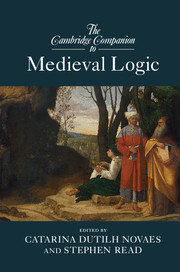Book contents
- Frontmatter
- Contents
- List of Contributors
- Introduction
- PART I PERIODS AND TRADITIONS
- PART II THEMES
- 8 Logica Vetus
- 9 Supposition and Properties of Terms
- 10 Propositions: Their Meaning and Truth
- 11 Sophisms and Insolubles
- 12 The Syllogism and Its Transformations
- 13 Consequence
- 14 The Logic of Modality
- 15 Obligationes
- Bibliography
- Index
9 - Supposition and Properties of Terms
from PART II - THEMES
Published online by Cambridge University Press: 05 September 2016
- Frontmatter
- Contents
- List of Contributors
- Introduction
- PART I PERIODS AND TRADITIONS
- PART II THEMES
- 8 Logica Vetus
- 9 Supposition and Properties of Terms
- 10 Propositions: Their Meaning and Truth
- 11 Sophisms and Insolubles
- 12 The Syllogism and Its Transformations
- 13 Consequence
- 14 The Logic of Modality
- 15 Obligationes
- Bibliography
- Index
Summary
INTRODUCTION
In the late twelfth and early thirteenth centuries, the writings of Aristotle became central to the logic curriculum (see Chapters 4 and 5). However, in a number of new developments, some topics with which Aristotle had not been concerned now began to make an appearance, and went on to become crucial within the tradition. These innovations were not regarded as an alternative to the Aristotelian logic, but rather supplemented it under the heading “logic of the moderns” (logica moderna or logica modernorum) (De Rijk 1962–1967). Probably the most prominent among the new topics were the doctrines of the so-called properties of terms (proprietates terminorum), which are generally considered the basis for later medieval semantic theorising and adjacent issues.
Terms (termini) in the technical sense presupposed here (and pointing to the “terminist” tradition) are descriptive words which function as subject or predicate in a proposition. The basic idea of the “properties” (or terministic) approach is that an analysis of the semantics of (compound) linguistic expressions should proceed by analysing the semantic properties of the terms occurring in it. In handbooks of logic from the later Middle Ages, the treatment of the properties started with signification (significatio), the capacity of terms to function as signs; supposition (suppositio), the property of terms functioning as subject or predicate in propositions, was its centrepiece, but the framework also covered related properties like copulation, appellation, ampliation, restriction, and distribution.
In the earlier stages of development, supposition had been one among the other properties with equal standing. From the works of Anselm of Canterbury, Peter Abelard and other less-well-known or anonymous authors, supposition theory began to emerge in the (late) twelfth century, and was then further developed through the thirteenth and fourteenth centuries. Though clearly dependent on grammarian traditions (Ashworth 2010, 152ff.) and closely connected with the theory of fallacies in its early stages, later on the framework developed in response to a variety of sometimes divergent needs in clarifying truth conditions, investigating the validity of inference forms, and making ontological commitments explicit. It is thus important to keep in mind that both across the centuries and in terms of different applications, the doctrines of the properties of terms form a rather heterogeneous collection in terms of function and application, as well as in terms of details of the machinery (Read 2015).
- Type
- Chapter
- Information
- The Cambridge Companion to Medieval Logic , pp. 220 - 244Publisher: Cambridge University PressPrint publication year: 2016
- 5
- Cited by

